Staffordshire Steam extravaganza
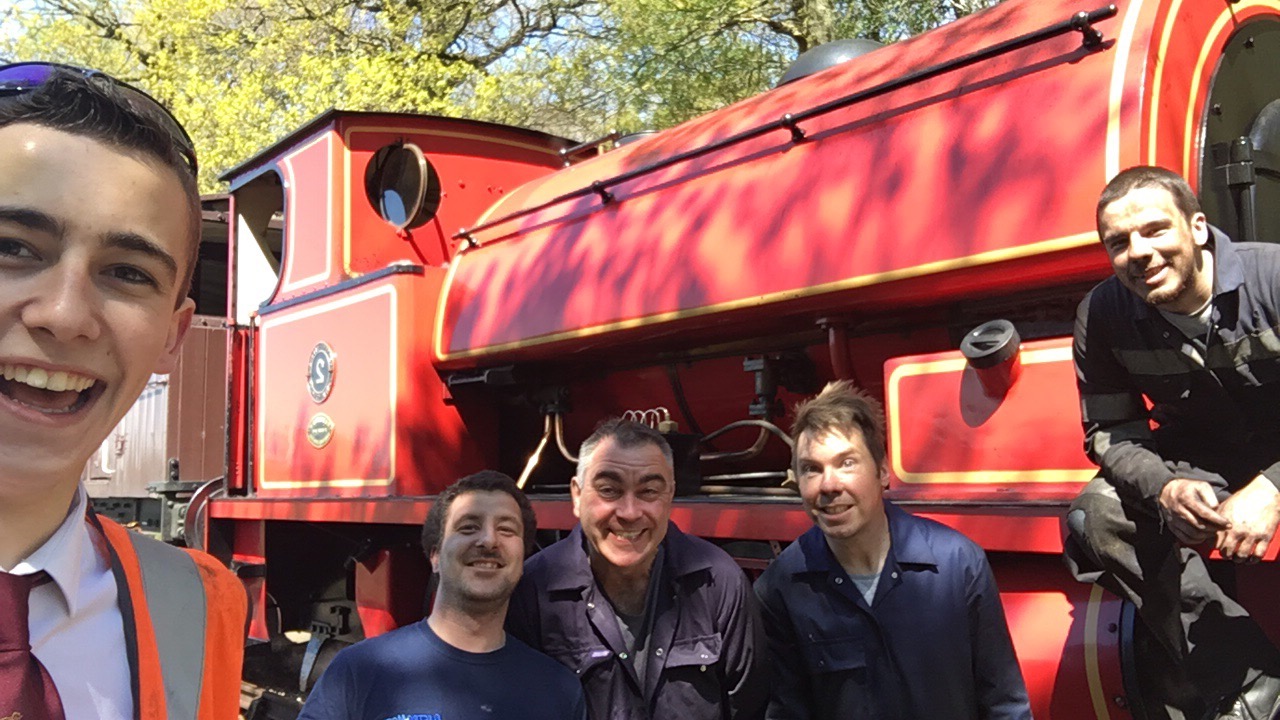 The British are incessant complainers (but we're very polite about it and we’ll queue to complain if necessary), that’s not to say what they're whining about isn’t justified. Take UK rail fares for instance, compared to Europe our main line trains are slower, dirtier, smellier (our trains release poo onto the tracks from the toilets), busier, and up to ten times more expensive (compared to travelling the same distance in Europe).
The British are incessant complainers (but we're very polite about it and we’ll queue to complain if necessary), that’s not to say what they're whining about isn’t justified. Take UK rail fares for instance, compared to Europe our main line trains are slower, dirtier, smellier (our trains release poo onto the tracks from the toilets), busier, and up to ten times more expensive (compared to travelling the same distance in Europe).
Now here’s the irony, Brits are willing to pay extortionate prices to travel on even slower, older trains, for just a few miles not actually going anywhere. Yes, I’m talking about heritage steam trains. During the end of September three heritage railways within a few miles of each other are all in steam and I'm on my way to them. It’s costing a bomb to get there, it’s 140 miles away, and I have to stay overnight, and all to travel on three small steam railways. I can’t wait!
Here's a shout out to the volunteers- When steam engines were a working entity, it was efficient to keep them going 7 days a week and when not actually in service, they would’ve been kept warm 24/7 enabling the machine to be readied for more work in around 45 minutes. Heritage steam locomotives are only run on certain days, you can’t just light a fire in boiler on an engine that’s cold, the stress’s on the machine would be too much. So before we turn up to marvel at these cognizant iron horses, the volunteers have likely been up the night before nursing the loco’s heart back to life.
Day 1- Newport to Stoke-on-Trent (train)
 It’s been four years since I began a cycle ride (The Biddulph Valley Way) from this station and little did I know that that ride would be cut short when I fell off and broke my collarbone. Nothing has changed with the station, it's still a beautifully preserved covered Victorian building, which opened in 1848. Being grade II listed, only the shell is preserved as it was when it was built, the inside has been modernised. You walk out onto ‘Winton Square’, said to be the only town square in the UK designed by a railway company- the North Staffordshire railway Co (NSR). The NSR built a hotel in the square, which it used as it’s central offices, some railway cottages adjacent and of course the station itself. The Hotel (now called the North Stafford) was built a year later than the station in 1849 and it too is grade II listed along with the cottages and a sculpture of Josiah Wedgwood the famous pottery designer. I will be staying in this hotel tonight and visiting the Victoria hall theatre for a Neil Diamond tribute act (I would prefer 'shine on you crazy diamond' rather than neil Diamond). I walked back to the hotel from the theatre after the show (and maybe I shouldn’t have), the streets were deserted (at 2200), as if there was a military curfew. It was very eerie.
It’s been four years since I began a cycle ride (The Biddulph Valley Way) from this station and little did I know that that ride would be cut short when I fell off and broke my collarbone. Nothing has changed with the station, it's still a beautifully preserved covered Victorian building, which opened in 1848. Being grade II listed, only the shell is preserved as it was when it was built, the inside has been modernised. You walk out onto ‘Winton Square’, said to be the only town square in the UK designed by a railway company- the North Staffordshire railway Co (NSR). The NSR built a hotel in the square, which it used as it’s central offices, some railway cottages adjacent and of course the station itself. The Hotel (now called the North Stafford) was built a year later than the station in 1849 and it too is grade II listed along with the cottages and a sculpture of Josiah Wedgwood the famous pottery designer. I will be staying in this hotel tonight and visiting the Victoria hall theatre for a Neil Diamond tribute act (I would prefer 'shine on you crazy diamond' rather than neil Diamond). I walked back to the hotel from the theatre after the show (and maybe I shouldn’t have), the streets were deserted (at 2200), as if there was a military curfew. It was very eerie.
Day 2- Stoke-on-Trent- via Apedale and Mill Meeece to Stone (30 miles)
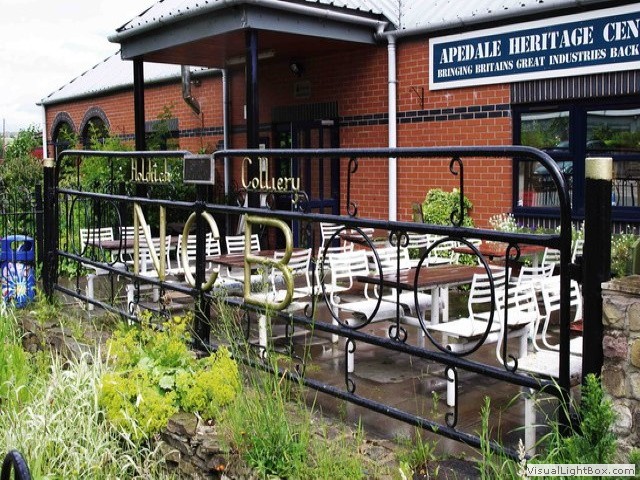 The heavens opened, and I mean like a bucket. Prior to the trip, I had taken my ‘cape’ out of retirement. Surpizingly, it kind of worked, I say kind of because you still get wet, but stay warm. My first stop is on the site of an old Colliery- Apedale heritage centre. The colliery closed in 1988, but was taken over by the audacious workers and transformed into a thriving mine museum and heritage railway. I walked into the centre trailing a small stream of water behind me, quickly mopped up by the staff. The mine tour starts at 1100 and begins by lamping up and then a briefing, the tour guide then took us into a drift mine, much as the same way miners did since the mine opened in 1940. I didn’t do the full tour as I had more to see today. The centre also has a narrow gauge railway which re-located here in 2010, but the colliery did have a branch line here (which we ride on when we leave). After a short ride through a leafy wet wood we turn south onto a shale track, past the old Silverdale colliery wheel, eventually returning to a nice tarmac path on the former north Staffordshire railway and then on quiet country roads to Whitmore. Here is Whitmore Hall a fine example of a small Carolean style manor house which has been a family home for hundreds years. Though, I feel the real crowning achievement to this estate is Whitmore St Mary & all Saints church. The Belfry was a late addition in the early 1900’s, when it became fashionable to finish buildings in a black and white veneer copying an earlier medieval building style. It’s the most unique looking church I’ve seen and very pleasurable to the eye.
The heavens opened, and I mean like a bucket. Prior to the trip, I had taken my ‘cape’ out of retirement. Surpizingly, it kind of worked, I say kind of because you still get wet, but stay warm. My first stop is on the site of an old Colliery- Apedale heritage centre. The colliery closed in 1988, but was taken over by the audacious workers and transformed into a thriving mine museum and heritage railway. I walked into the centre trailing a small stream of water behind me, quickly mopped up by the staff. The mine tour starts at 1100 and begins by lamping up and then a briefing, the tour guide then took us into a drift mine, much as the same way miners did since the mine opened in 1940. I didn’t do the full tour as I had more to see today. The centre also has a narrow gauge railway which re-located here in 2010, but the colliery did have a branch line here (which we ride on when we leave). After a short ride through a leafy wet wood we turn south onto a shale track, past the old Silverdale colliery wheel, eventually returning to a nice tarmac path on the former north Staffordshire railway and then on quiet country roads to Whitmore. Here is Whitmore Hall a fine example of a small Carolean style manor house which has been a family home for hundreds years. Though, I feel the real crowning achievement to this estate is Whitmore St Mary & all Saints church. The Belfry was a late addition in the early 1900’s, when it became fashionable to finish buildings in a black and white veneer copying an earlier medieval building style. It’s the most unique looking church I’ve seen and very pleasurable to the eye.
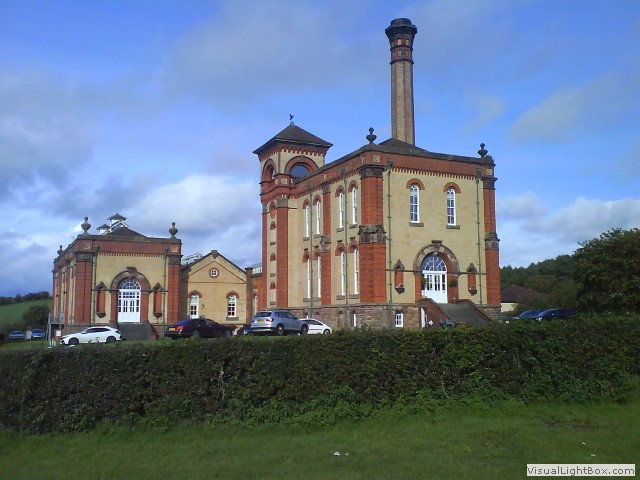 Just before turning right off the main road is Hatton water works built by the Staffordshire Potteries Waterworks Company. The lovely Victorian building constructed in red and cream brick is still there, but the steam engines were removed sometime after the war. After a short stint following the main railwayline we come to Mill Meece pumping station also built by the Staffordshire Potteries Waterworks Company, closed to tours today, but this great Victorian pumping station (which houses a steam driven pump) is still visable from the road.
Just before turning right off the main road is Hatton water works built by the Staffordshire Potteries Waterworks Company. The lovely Victorian building constructed in red and cream brick is still there, but the steam engines were removed sometime after the war. After a short stint following the main railwayline we come to Mill Meece pumping station also built by the Staffordshire Potteries Waterworks Company, closed to tours today, but this great Victorian pumping station (which houses a steam driven pump) is still visable from the road.
I love trains, but this part of the line must be flat out, the noise is really bloodcurdling and goes right through you. I can barely describe the screaming ear piercing sound the trains made as they rushed past, like the ‘Millennium Falcon’ from Star wars. We skirt around MOD Swynnerton (formally ROF Swynnerton) which was once a ‘filling' factory for the most dangerous types of highly combustible munitions. Now a military training camp with just derilict buildings, but still closed off to the public, it would have been an interesting diversion. I was due to ride back along the canal to Stoke-on-Trent, but it was too soggy, so we headed for Stone station. The station sits on the confluence of two main lines, and had two stations. The West line station and platform was taken away after the war, Stoke junction station was then rebuilt to what we see today.
Day 3/1- The Foxfield railway (11 miles cycle & train)
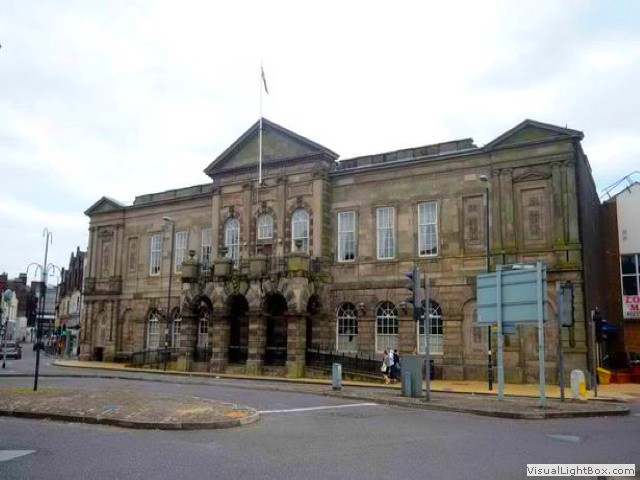 Today is going to be a long day (but not many miles), I left the hotel at 0800 and followed the City road out of Stoke-on-Trent heading towards Longton. The roads were car free and almost abandoned (the same as Friday night). In fairness the route threw up an unexpected smorgasbord of 19th Century pottery buildings, some derelict, some converted to commercial properties. We turned left at Longton town hall (now being re-furbished) and onto a cycle path next to the A50, arriving at Caverswall Road station.
Today is going to be a long day (but not many miles), I left the hotel at 0800 and followed the City road out of Stoke-on-Trent heading towards Longton. The roads were car free and almost abandoned (the same as Friday night). In fairness the route threw up an unexpected smorgasbord of 19th Century pottery buildings, some derelict, some converted to commercial properties. We turned left at Longton town hall (now being re-furbished) and onto a cycle path next to the A50, arriving at Caverswall Road station.
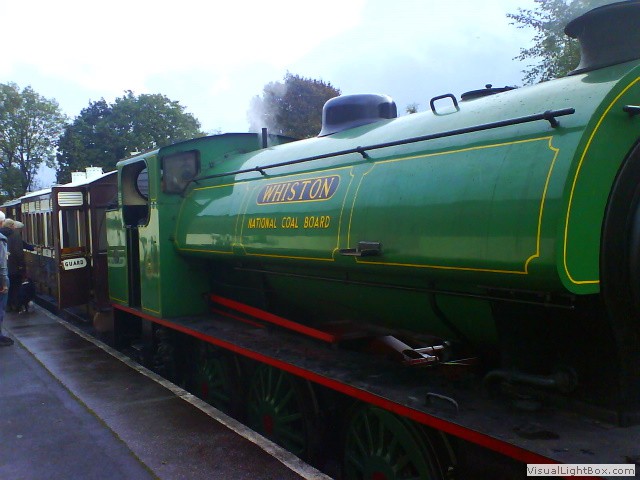 The Foxfield line was built in 1893 to serve the colliery at Dilhorne on the Cheadle Coalfield, and was never a true passenger route. The journey starts at Caverswall Road, the station and depot here were purpose built for the heritage line. During the building of the line earthworks were kept to a minimum resulting in a railway with huge gradients, running as steep as 1:19 in places, it’s the steepest adhesion worked standard gauge line in Britain. Our little saddle tank painted in National Coal Board livery groaned and panted as it pulled off. The length of the line is tiny at 2½ miles, but it is pretty. It terminates at a little halt in the middle of no-where, the railway isn't allowed to convey passengers to Dilhorne colliery (it's deemed as too steep), you have to walk there across a saturated muddy field and over three stiles, I had no alternative but to go back to the main station and ride to the colliery on the road. There the surface remains consist of a winding engine house, two headgears, pit baths, offices and also the pit yard and entrance lodge. Many of the buildings are still in private industrial use, but the winding house and headgears are under the care of the Foxfield Railway.
The Foxfield line was built in 1893 to serve the colliery at Dilhorne on the Cheadle Coalfield, and was never a true passenger route. The journey starts at Caverswall Road, the station and depot here were purpose built for the heritage line. During the building of the line earthworks were kept to a minimum resulting in a railway with huge gradients, running as steep as 1:19 in places, it’s the steepest adhesion worked standard gauge line in Britain. Our little saddle tank painted in National Coal Board livery groaned and panted as it pulled off. The length of the line is tiny at 2½ miles, but it is pretty. It terminates at a little halt in the middle of no-where, the railway isn't allowed to convey passengers to Dilhorne colliery (it's deemed as too steep), you have to walk there across a saturated muddy field and over three stiles, I had no alternative but to go back to the main station and ride to the colliery on the road. There the surface remains consist of a winding engine house, two headgears, pit baths, offices and also the pit yard and entrance lodge. Many of the buildings are still in private industrial use, but the winding house and headgears are under the care of the Foxfield Railway.
Day 3/2- The Churnet Valley railway (9 miles cycle & train)
 It’s now back on the bike to the Churnet Valley railway, the weather decanted sheets of rain down on me as I rode through some nice quiet lanes, some of which were flooded. The problem riding through floods is you don't know what's underneath- there could be a drain cover off and then you're off. Finally we dropped down a steep road to the Churnet heritage line. The line went south east to Uttoxeter and north west to Manchester and was shut in 1965. In 2015 I rode part of this line (The Churnet Valley way) starting from Denstone past the fantastic chocolate box station of Alton to the now closed Oakamoor tunnel, so it’s good to be back to continue the journey on the former line.
It’s now back on the bike to the Churnet Valley railway, the weather decanted sheets of rain down on me as I rode through some nice quiet lanes, some of which were flooded. The problem riding through floods is you don't know what's underneath- there could be a drain cover off and then you're off. Finally we dropped down a steep road to the Churnet heritage line. The line went south east to Uttoxeter and north west to Manchester and was shut in 1965. In 2015 I rode part of this line (The Churnet Valley way) starting from Denstone past the fantastic chocolate box station of Alton to the now closed Oakamoor tunnel, so it’s good to be back to continue the journey on the former line.
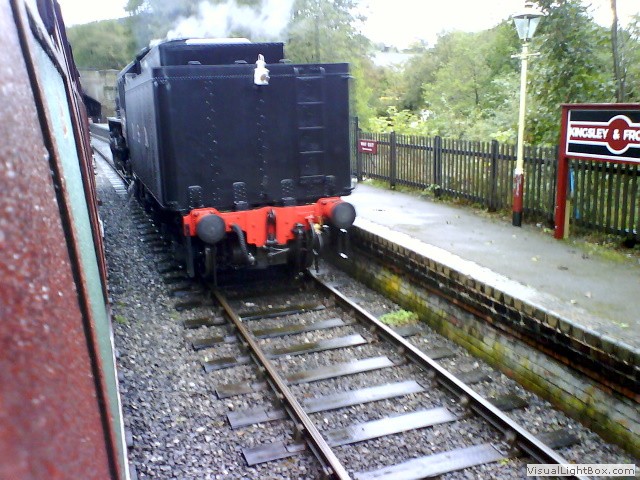 I optimistically left the bike in the guards van (hoping I could ride back) and hopped aboard the train at Froghall Station. Straight away we pass the historic copper factory of Thomas Bolton & sons. Now following the swollen river Churnet, we stopped at the popular picturesque station of Consall, where we cross over the canal. The steep valley opens up to marshland, I was due to get off at Cheddleton station and ride back on the canal, but the water overflowed the path, so it would have been foolhardy to ride back, so I returned on the train. The railway is known as Staffordshire's "Little Switzerland", but I didn’t quite get that view through the steamed up windows, but it was nice enough. I left the train and proceeded towards Whiston hall hotel up a stupidly steep road. The hotel was such a blessing- nice food, nice beer and a nice sleep
I optimistically left the bike in the guards van (hoping I could ride back) and hopped aboard the train at Froghall Station. Straight away we pass the historic copper factory of Thomas Bolton & sons. Now following the swollen river Churnet, we stopped at the popular picturesque station of Consall, where we cross over the canal. The steep valley opens up to marshland, I was due to get off at Cheddleton station and ride back on the canal, but the water overflowed the path, so it would have been foolhardy to ride back, so I returned on the train. The railway is known as Staffordshire's "Little Switzerland", but I didn’t quite get that view through the steamed up windows, but it was nice enough. I left the train and proceeded towards Whiston hall hotel up a stupidly steep road. The hotel was such a blessing- nice food, nice beer and a nice sleep
Day 4- Whiston via Blythe bridge to Stoke-on-Trent (9 miles cycle & train)
 After descending back down the stupidly steep hill from the hotel, I popped into Froghall Wharf, now the sleepy end to the Caldon Canal. Two centuries ago Froghall Wharf was a thriving industrial transport hub, equipped with lime kilns, warehousing and a meeting point for both the canal and railway networks. I didn't have much time there and had to ride on heading for Cheadle. The hills were substantial and challenging even with an electric bike, the previous wet days had put the system through its paces and left a residual electrical burning smell. We arrived in Cheadle around 0950, a rather boring one street town, though there were some nice Tudor type buildings on the way out. I arrived in Blythe Bridge at 1010 and caught the train back to Stoke-on-Trent, my train home was 1100, so I didn't have time to ride there.
After descending back down the stupidly steep hill from the hotel, I popped into Froghall Wharf, now the sleepy end to the Caldon Canal. Two centuries ago Froghall Wharf was a thriving industrial transport hub, equipped with lime kilns, warehousing and a meeting point for both the canal and railway networks. I didn't have much time there and had to ride on heading for Cheadle. The hills were substantial and challenging even with an electric bike, the previous wet days had put the system through its paces and left a residual electrical burning smell. We arrived in Cheadle around 0950, a rather boring one street town, though there were some nice Tudor type buildings on the way out. I arrived in Blythe Bridge at 1010 and caught the train back to Stoke-on-Trent, my train home was 1100, so I didn't have time to ride there.
-
Gallery
 Why not have a look at the gallery relating to this ride. Click the image or the title.
Why not have a look at the gallery relating to this ride. Click the image or the title. -
Victoria Hall
 Victoria Hall was constructed in local red brick and terracotta as an annex to Hanley Town Hall built in 1888, as part of the city's celebrations for Queen Victoria's Golden Jubille.
Victoria Hall was constructed in local red brick and terracotta as an annex to Hanley Town Hall built in 1888, as part of the city's celebrations for Queen Victoria's Golden Jubille. -
Apedale heritage centre
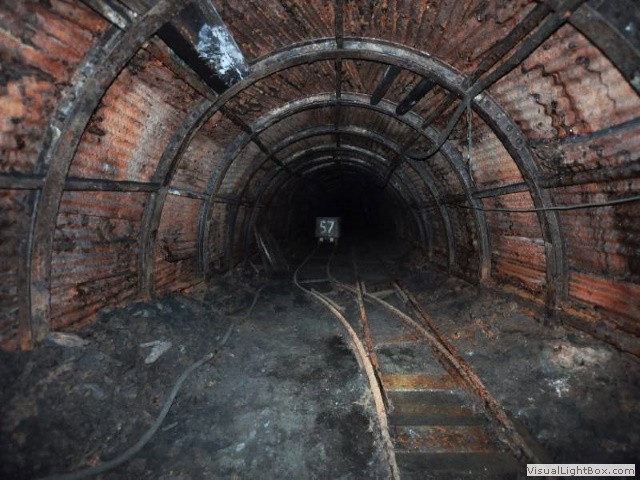 The heritage centre was in two sections- A mine and a narrow light gauge railway. Our guide was an ex-miner, but not from this pit. He explained the coal here went down diagonally from the surface, so the miners just followed the coal making it a drift mine. This mine was only opened in 1940 and shut in the eighties.
The heritage centre was in two sections- A mine and a narrow light gauge railway. Our guide was an ex-miner, but not from this pit. He explained the coal here went down diagonally from the surface, so the miners just followed the coal making it a drift mine. This mine was only opened in 1940 and shut in the eighties.
The railway was opened here in 2010 after being re-located from south Manchester. It was run by the Moseley Railway Trust who now hold a major collection of British industrial narrow gauge locomotives. -
Whitmore St Mary & all Saints church
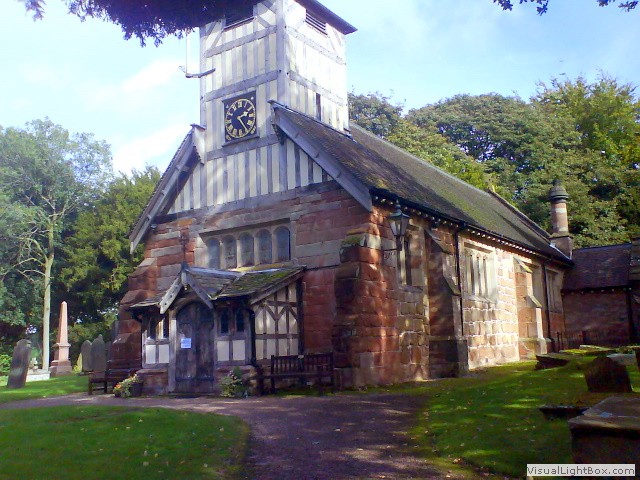 There has been a church here since C11, but it was completely restored in late C19, adding the clock on west
face to commemorate Queen Victoria's Diamond Jubilee in 1897.
There has been a church here since C11, but it was completely restored in late C19, adding the clock on west
face to commemorate Queen Victoria's Diamond Jubilee in 1897. -
Mill Meece pumping station
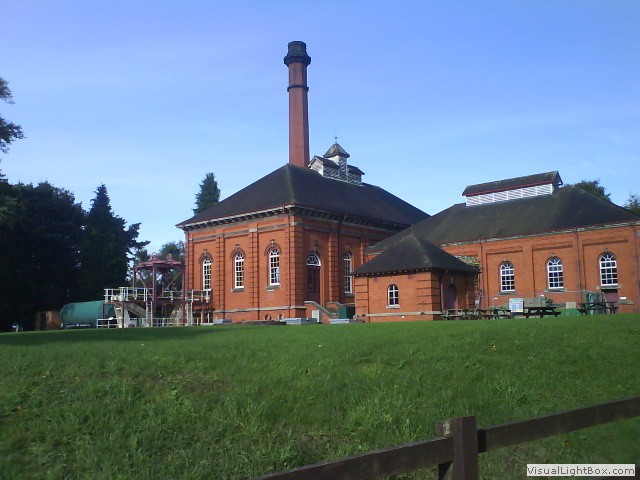 The pumping station had two boreholes and two steam engines built in 1915 though did not pump to the public water supply until 1919. Both engines continued to operate until 1979. Water is still pumped from the Mill Meece site though now by electric pumps, but the original steam engines remain.
The pumping station had two boreholes and two steam engines built in 1915 though did not pump to the public water supply until 1919. Both engines continued to operate until 1979. Water is still pumped from the Mill Meece site though now by electric pumps, but the original steam engines remain. -
Stoke-on-Trent potteries
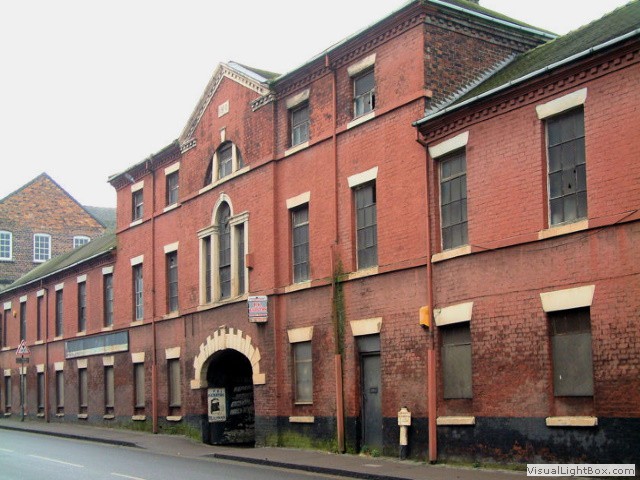 Since the 17th century, Stoke-on-Trent has almost exclusively been known for its industrial-scale pottery manufacturing. On City Road there were at least ten pottery companies (and more around the area). Local abundance of coal and
Since the 17th century, Stoke-on-Trent has almost exclusively been known for its industrial-scale pottery manufacturing. On City Road there were at least ten pottery companies (and more around the area). Local abundance of coal and
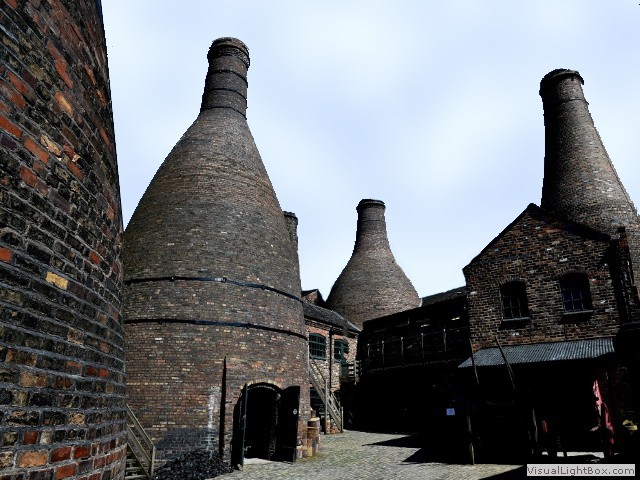 clay, suitable for earthenware production, initially led to the early development of the pottery industry. When the local clay dwindled the Trent and Mersey Canal was constructed and completed in 1777, then china clay was imported from Cornwall making a new type of bone china. Clck the images for more.
clay, suitable for earthenware production, initially led to the early development of the pottery industry. When the local clay dwindled the Trent and Mersey Canal was constructed and completed in 1777, then china clay was imported from Cornwall making a new type of bone china. Clck the images for more. -
Dilhorne colliery
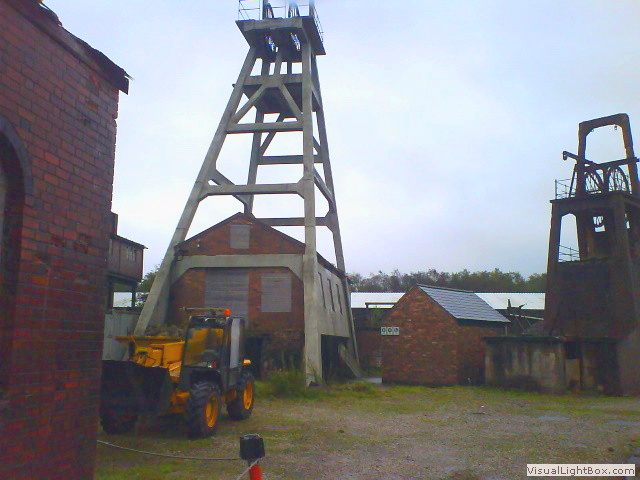 A shaft was sunk in 1880, and you can still see the pit shaft under the winding gear. Dilhorne colliery continued to grow and by 1893 Foxfield became the first mine in Cheadle area to have its own rail connection to the national rail network, joining the line at Blythe Bridge.
A shaft was sunk in 1880, and you can still see the pit shaft under the winding gear. Dilhorne colliery continued to grow and by 1893 Foxfield became the first mine in Cheadle area to have its own rail connection to the national rail network, joining the line at Blythe Bridge. -
Thomas Bolton & sons Froghall
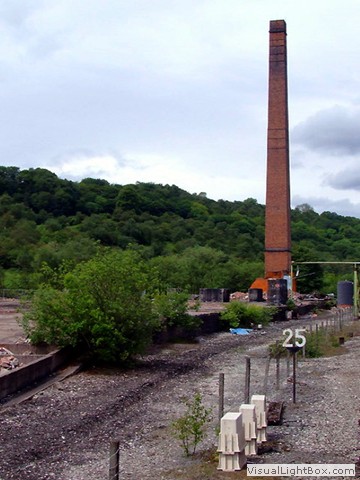 After 200 years of copper production on this site the company went into administration in 2010, it was said Froghall was the last remaining manufacturer of copper in Britain. A lot of the factory stood derelict before being demolished in 2011. However, a last minute intervention saved an original chimney which is still standing.
After 200 years of copper production on this site the company went into administration in 2010, it was said Froghall was the last remaining manufacturer of copper in Britain. A lot of the factory stood derelict before being demolished in 2011. However, a last minute intervention saved an original chimney which is still standing. -
Addendum
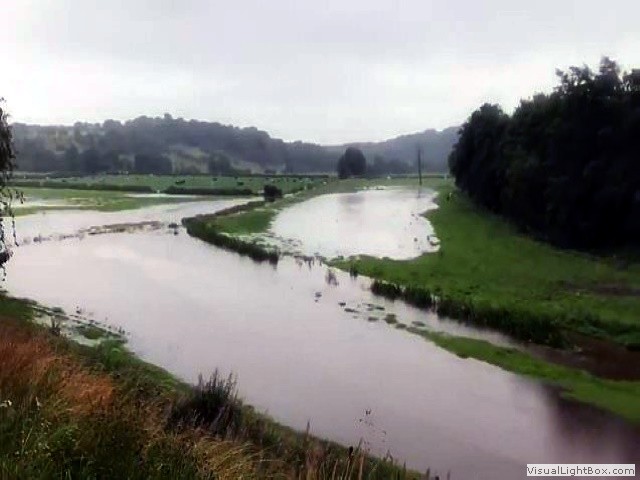 The weather forecast had it totally wrong, it was supposed to be light rain showers, but it was heavy for hours every morning, I had a daily drenching. I was gob-smacked by the missing people in the City on the Friday night, after speaking to a PCSO on Saturday, the reason became apparent. Stoke-on-Trent has yielded to gang culture and families are living in fear of the drug gangs terrorising the streets after a surge in stabbings in recent weeks.
The weather forecast had it totally wrong, it was supposed to be light rain showers, but it was heavy for hours every morning, I had a daily drenching. I was gob-smacked by the missing people in the City on the Friday night, after speaking to a PCSO on Saturday, the reason became apparent. Stoke-on-Trent has yielded to gang culture and families are living in fear of the drug gangs terrorising the streets after a surge in stabbings in recent weeks. 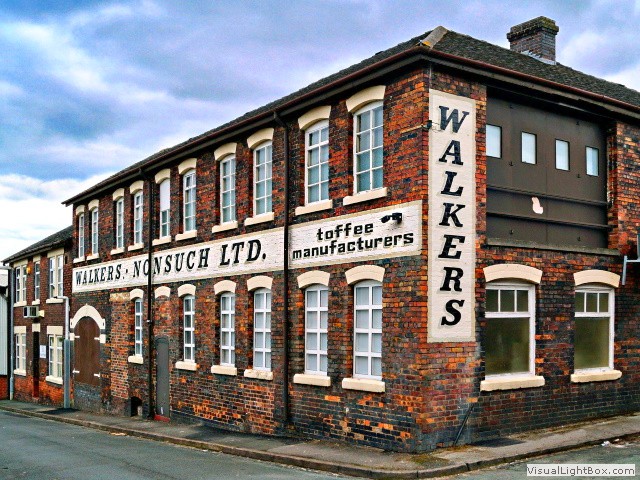 That said the City has an extraordinary union with its Victorian past. Lots of listed buildings are derelict, but many are refurbished into useful structures. The City has kept its terraced housing, and I love this. Many Cities ripped these down in favour of new social housing estates, but in my experience- that has made the situation worse. Stoke-on-Trent is trying to modernise but with sensitivity, clearly money is not flowing fast enough and again work is sparse. I shall watch the City closely over the next few years and hope good will prevail.
That said the City has an extraordinary union with its Victorian past. Lots of listed buildings are derelict, but many are refurbished into useful structures. The City has kept its terraced housing, and I love this. Many Cities ripped these down in favour of new social housing estates, but in my experience- that has made the situation worse. Stoke-on-Trent is trying to modernise but with sensitivity, clearly money is not flowing fast enough and again work is sparse. I shall watch the City closely over the next few years and hope good will prevail.
